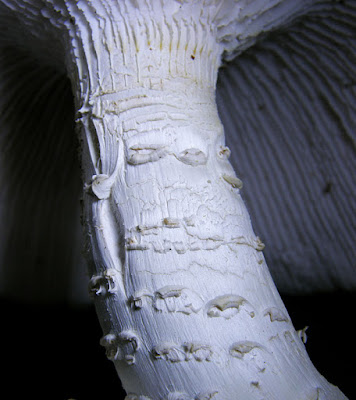September. I’ve seen Neolentinus lepideus, the Train
Wrecker, on several occasions along the trail from the picnic shelter A to the
Old Fort. These are striking mushrooms. They grow mainly on conifers and,
occasionally, on hardwoods. I’ve found them growing on the stumps or fallen
trunks of pine trees. Previously, I’d seen them in winter and early spring so I
was surprised to find these in late September.
I
didn’t see them as I walked north, but I couldn’t miss them on my way back down
the trail. It’s easy to see why I couldn’t miss them.
They
are impressive from a distance but, up close, these were works of art.
The
cap diameter of the largest mushroom was approximately 4 inches. The brown scales
that develop on the caps are one of the features for identifying these mushroom.
Views
of these mushrooms, from the underside.
Scales
are present on the stems are another identifying feature, as are…
the serrated margins on the
gills.
The
common name of this mushroom, Train Wrecker, derives from the fact that these
mushrooms can grow on, and cause rotting of, treated wood used as railroad
ties. Rotting of the ties has resulted in train derailments.
Neolentinus
lepideus occurs frequently in the northern hemisphere, but has been documented
in Australia.
References:
Messiah
College: Neolentinus
lepideus
Discover
Life: Neolentinus
lepideus








No comments:
Post a Comment